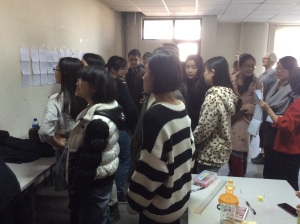Abbie Hunt, graduate of BA(Hons) Fine Art and recipient of a 2017 Venice Fellowship, funded by the British Council and Falmouth School of Art, reflects on her experience of one month living in Venice as part of the British Council’s Research Stewardship Programme at the 57th Biennale Arte…

‘I don’t think I knew what to expect until my first day on the job, but that was the exciting part. Stewarding is hard work; I never anticipated the endurance of standing in a corner of a room, observing the visitors, observing the work. It’s mentally draining to be with your thoughts for so long. I’m the kind of person who doesn’t stop, so for my job role to suddenly be so stationary was a shock.
Furthermore, I never realised how little the ideas surrounding art fell away when you become a Steward. You spend such an unnatural amount time with a piece of work that you have phrases of being grossly interested and unexpectedly numb towards it. I spent lull periods scribbling personal observations down, but when it came to discussing the artwork with a visitor, it was as if I was reciting a script. People wanted a 3-minute summary of the work before they moved onto the next pavilion, there was no time for contemplation and it was strange to be so detached.
 Entwining my research project with my stewarding duties made my experience so insightful. I focused on observing visitors’ reactions and opinions surrounding Phyllida Barlow’s Folly. I was already well versed in Barlow’s career, therefore the experience contributed to my work as a form of practical research.
Entwining my research project with my stewarding duties made my experience so insightful. I focused on observing visitors’ reactions and opinions surrounding Phyllida Barlow’s Folly. I was already well versed in Barlow’s career, therefore the experience contributed to my work as a form of practical research.
What I gained from the Venice Fellowship was an intense period of learning about myself. I have never traveled alone before and it completely changed my perspective on how I acted. I didn’t feel like a tourist but neither a local, and it was strange limbo I endured whilst discovering things about me as a person that I have never noticed before. It was an emotional roller-coaster, but I think I’ve gained a greater understanding of who I am.
Overall, I think I gained confidence and independence. Talking to strangers on a daily basis and having the knowledge to pass on to others was a good feeling because I’ve never had the opportunity to do so before. Giving people an insight or starting point to lead them through the maze of art within the Biennale was satisfying. I’d see their face light up with understanding and know I’d made a difference to their experience.
Similarly, confidence fed into my research project. It was an opportunity to collate research and write about my findings without the baring of education. Research is a guilty pleasure and it was strange to realise I still had the motivation to learn without the bounds of getting a grade at the end of it.
 The biennale has a hub of social activity on throughout the time it is open; other countries create events so stewards can mingle, and are very appreciative when you make the effort to join in. Reflecting on the experience would be incomplete without mentioning my extended family of my October Fellows. Our intense company definitely kept us all going and I honestly wouldn’t have been able to get through my experience without them. We’ve already met in London since being home before Christmas. Our unexpected bond of being in the same bizarre situation has gave us all such a strong friendship.
The biennale has a hub of social activity on throughout the time it is open; other countries create events so stewards can mingle, and are very appreciative when you make the effort to join in. Reflecting on the experience would be incomplete without mentioning my extended family of my October Fellows. Our intense company definitely kept us all going and I honestly wouldn’t have been able to get through my experience without them. We’ve already met in London since being home before Christmas. Our unexpected bond of being in the same bizarre situation has gave us all such a strong friendship.
Of course the art was memorable; I’ve never been so immersed in an abundance of artwork to observe and it definitely made me speechless on many occasions. My favourite was the Intuition Exhibition at the Palazzo Fortuny. I also felt we were the luckiest of months out of the Fellowship scheme as I actually got to meet Phyllida Barlow herself! It was a huge moment for me. Just days before we were set to go back to reality, Barlow visited the Biennale with her family and hadn’t seen her own work since the opening in May. I fangirled hard and was pretty star struck. You read so much about an artist, they inspire your practice and you empathise with their work…I thought spending time with her sculptures was gratification enough but seeing her next to them in the flesh was the cherry on the top. It’s a moment I’ll never forget and just seemed like the perfect present, a personal nod to keep going after three years of my degree.
From my experience as a steward, I’ve realised that the public face of the artwork is not who I want to be; but the gallery still remains my focus. I am ideally looking towards a technical position within a gallery, since the install and de-install of Phyllida Barlow’s work was a continuous consideration. Being hands-on and retaining that essence of practice is my ideal route.’



























 S
S

